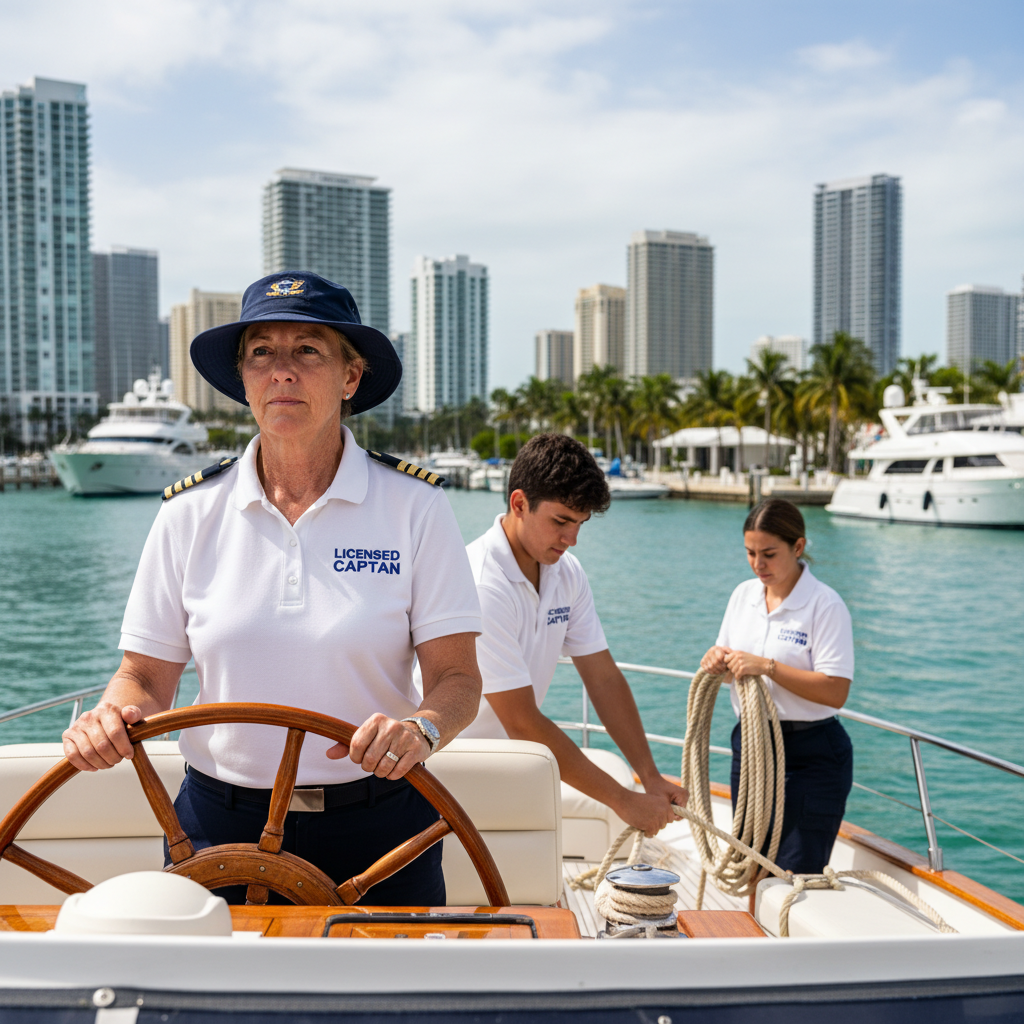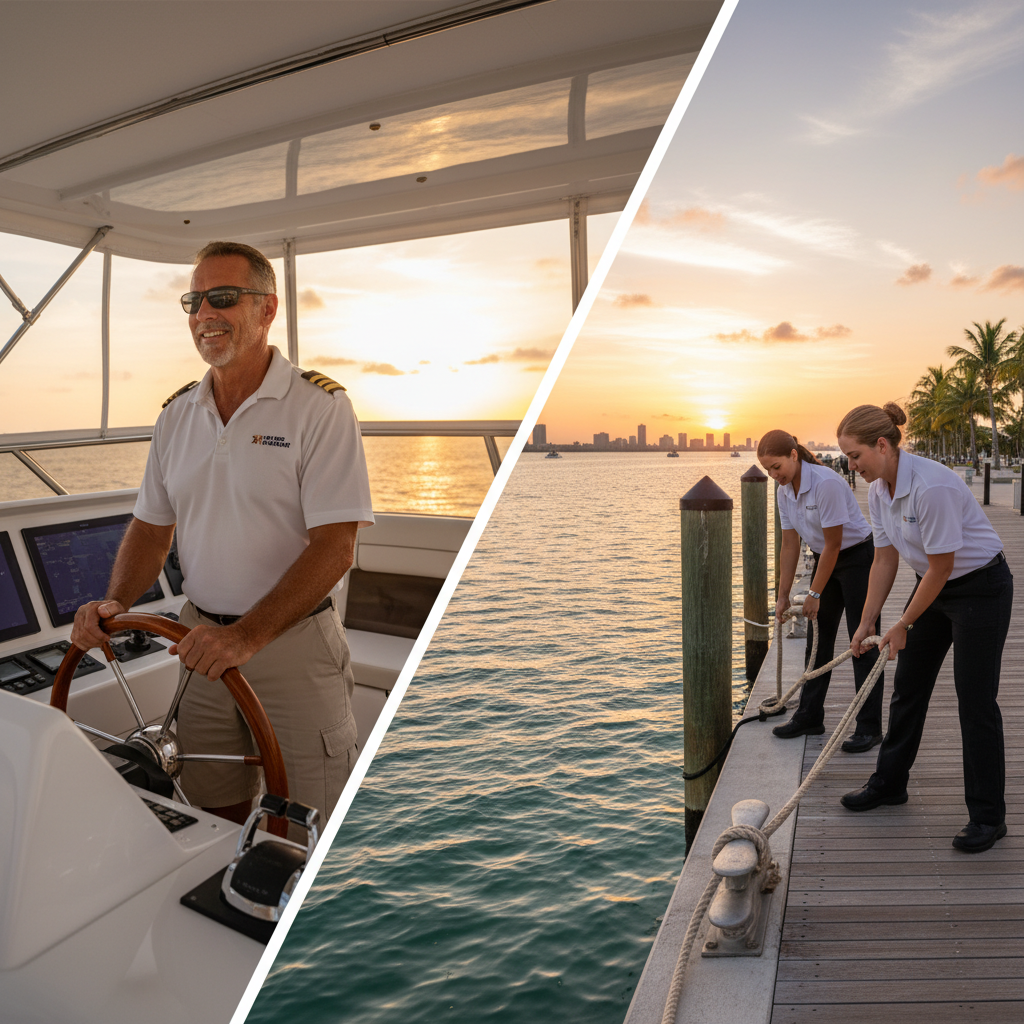
Miami yacht rentals with a licensed captain and crew
How to book a legal, safe, and unforgettable day on Biscayne Bay—vessels, passenger limits, routes, pricing, toys, and pro tips.
What “captain included” actually means in Miami
“Captain included” indicates a USCG-licensed professional operates your yacht for the duration of the charter. On fully crewed yachts, deckhands and stewards handle lines, service, toys, and guest care while the captain manages navigation, weather, and compliance. A captain’s presence does not automatically permit more than six passengers—capacity depends on the vessel’s inspection status and the charter structure.
Crewed, skippered, and bareboat—definitions that matter
- Crewed charter: Boat plus captain and crew; hospitality included and managed by the operator.
- Skippered charter: Licensed captain is included; smaller boats may have limited additional crew.
- Bareboat (demise) charter: You temporarily “take possession” of the vessel and select/pay the captain from an approved list; most are limited to 12 passengers even with crew.
Benefits of a licensed Miami crew
- Safety: Collision avoidance, anchoring, emergency response in busy areas like Government Cut.
- Local knowledge: Sand patches at Nixon, no-wake traps near Venetian Islands, tide timing.
- Service: Dock-and-dine coordination, toy setup, clean lines, and tidy decks for effortless fun.
Choose the right yacht for your group, route, and sea state
Motor yachts by size class
- 30–50 ft: Versatile for skyline loops and sandbar dips; fits small groups; captain-only or captain + 1.
- 50–80 ft: More shade and lounges; better ride for longer days; light ocean hops possible.
- 80–120 ft: Multi-zone entertaining, stabilizers, crew quarters—great for premium events or overnights.
- 120 ft+: Superyachts with chefs, toy garages, and strict passenger rules (COI required for >6 on-hire unless structured legally).
Catamarans and multihulls
- Sailing cats: Shallow draft, wide decks; excellent for sandbars and snorkeling.
- Power cats: Faster with level ride—ideal for families, elders, or motion-sensitive guests.
Sportfish and center consoles
- Speed and agility for reefs, river dining, or offshore fishing when weather cooperates.
- Less interior volume than monohull motor yachts of similar length.
Party pontoons and day cruisers
- Budget-friendly for short bay hops and sandbar hangs; many lack heads and storage.
- More sensitive to wind and chop; keep routes sheltered.
Luxury vs. value considerations
- Luxury: Separate salons, flybridge lounges, multiple heads, A/C interiors, stabilizers.
- Value: Core comfort with simpler finishes and smaller toy lists to keep rates lean.
Match boat to group size, occasion, and sea conditions
- 6–8 guests, 3–4 hours: 35–45 ft motor yacht or power cat; morning departures for calmer seas.
- 10–12 guests: 50–70 ft for multiple deck zones and shaded seating.
- Photo-forward celebrations: Flybridge layouts and bow lounges; easy water access for sandbars.
Legal compliance and passenger limits in Miami
USCG uninspected vs. inspected vessels
- UPV (Uninspected Passenger Vessel): Up to six passengers for hire with a licensed captain.
- Inspected vessel (COI): Legal capacity listed on the COI, with approved routes and safety equipment.
Licenses: OUPV “6-pack” vs. Master
- OUPV: Carries up to six passengers on UPVs within endorsement limits.
- Master (25/50/100 ton): Operates inspected vessels per tonnage/area endorsements; can also run UPVs.
Bareboat vs. fully crewed in practice
- Bareboat: Charterer assumes responsibility; typically max 12 passengers; must choose the captain; pays fuel/provisioning.
- Fully crewed: Simpler planning; must still respect inspection status and passenger caps.
Insurance, drug testing, and document checks
- Look for hull + P&I insurance, pollution liability, and DOT-compliant drug/alcohol testing for safety-sensitive crew.
- It’s normal to ask for captain license, COI (if applicable), and proof of insurance before booking.
Pickup locations and cruising grounds
Convenient marinas
- Miami Beach Marina: South Beach access; quick to Government Cut.
- Island Gardens: Hosts larger yachts; skyline views.
- Sea Isle Marina: Near Edgewater; fast access to Venetian Islands.
- Miamarina at Bayside: Central for downtown and Miami River.
- Haulover, Dinner Key, Crandon: Northern, southern, and Key Biscayne gateways.
Zones and no-wakes
- Biscayne Bay: Your main canvas—sheltered, scenic, and lively.
- Venetian Islands: Photogenic, strictly no-wake—expect patient piloting.
- Government Cut: Busy shipping channel; dramatic skyline and cruise-ship views.
Sandbars and etiquette
- Haulover: Dense crowds—mind spacing and respectful music.
- Nixon: Clearer water, family vibe; keep toys in designated areas.
- Monument Island: Photo stops; anchors outside swim zones.
- Boca Chita: Biscayne National Park; follow ranger guidance and mooring rules.
Environmental constraints
- Seagrass beds: Anchor in sand patches; shut down engines once set.
- Protected zones/manatee areas: Slow speed and no-wake compliance.
- Use reef-safe sunscreen and proper pump-outs.
Signature Miami itineraries with a captain
- Skyline + celebrity homes loop: Star, Hibiscus, Palm, Fisher Islands; timed for golden-hour light.
- Sandbar swim day: Haulover or Nixon with mats, SUPs, snorkel sets; swimmer lookout active.
- Miami River dock-and-dine: Seaspice, Kiki on the River, Garcia’s, The Wharf—reserve ahead.
- Biscayne National Park + Stiltsville: Mooring balls, snorkeling, leave-no-trace practices.
- Sunset and night cruise: Brickell reflections, port lights, South Beach skyline.
- Multi-day: Keys or Bimini (passports/customs, weather windows, fuel planning).
Durations, timing, and seasonality
- 2–3 hours: Photo/sunset loops. Half-day: Cruise + sandbar. Full-day: Cruise, swim, dine.
- Best seas: Morning departures, especially in summer before sea breeze/storms build.
- Peak season: Dec–Apr; shoulder seasons offer value; hurricane season needs flexible policies.
Pricing and total cost breakdown
- Base rate: Vessel and standard gear. Captain/crew may be included or separate on bareboat structures.
- Fuel: Metered at burn or a flat allowance for standard routes; surcharges for ocean runs.
- Taxes/fees: Sales tax, environmental fees, premium marina pickup or docking charges.
- Toys: Mats/SUPs often included; jet skis/Seabobs, slides, and inflatables are add-ons.
- Gratuity: 15–20% customary; larger yachts may add 18–20% service charge—clarify if that’s the crew tip.
Sample day rates (guidance only)
- 30–40 ft (half-day): high hundreds to ~ $1,800 depending on date/inclusions.
- 50–70 ft (half-day): ~ $2,000–$5,000; full-days scale up.
- 80–120 ft: ~ $6,000–$15,000+ for day use; superyachts higher.
Booking workflow: from inquiry to boarding
- Needs analysis: Guest count/ages, occasion, route, catering, toys, mobility or dietary notes.
- Shortlist and captain match: Verify compliance; align captain style with itinerary (family, party, fishing).
- Agreement and payments: Charter contract, deposit + balance, refundable security deposit, government ID.
- Pre-departure: Passenger manifest, waivers, special requests, weather brief and final route plan.
Contracts, insurance, cancellations
- Agreements: AYCA/MYBA for larger trips; local day-charter contracts for Miami.
- Coverage: Hull + P&I; ask for proof—corporate/media often require COIs and additional insured status.
- Weather/rescheduling: Unsafe conditions trigger reschedules/refunds per contract; peak dates have stricter terms.
Onboard experience, etiquette, and toys
Safety briefing and essentials
- Lifejacket locations, moving safely on deck, ladder use, muster points, VHF/communication protocols.
What’s provided vs. what to bring
- Often included: Ice, bottled water, cups, coolers, towels (confirm).
- Bring: Government IDs, reef-safe sunscreen, meds, agreed snacks/beverages in spill-proof containers.
Footwear, glass, smoking, and music
- Shoes-off or soft soles; acrylic drinkware preferred; designated smoking areas; respectful volume near others.
Alcohol, BYOB, and responsible service
- BYOB common; the captain may pace service or alter plans if safety is at risk.
Water toys and PWC rules
- Toy deployment: Engines off, secure anchor, swimmer lookout assigned, clear boundaries.
- Jet skis in Florida: Operators ≥14; renters ≥18; born on/after Jan 1, 1988 need boater card or temp cert; kill-switch lanyard required; obey manatee/no-wake zones.
Safety management
- Captain’s authority on route changes and go/no-go calls; real-time radar/wind monitoring; lightning protocols with NOAA marine forecasts.
- Seasickness: Morning runs, stable hulls, shaded midships seating, hydration, remedies taken in advance.
Environmental stewardship and accessibility
- No discharge; secure all trash and small plastics; avoid balloons; reef-safe sunscreen only.
- Wildlife etiquette: Slow for manatees; don’t chase dolphins; give seabird roosts space.
- Lighting and drones: Maintain nav visibility at night; follow FAA rules; many marinas restrict UAVs.
Accessibility and special requests
- Mobility: Choose boarding points with stable docks; request handrails/steps; reserve secure seating.
- Kids: Under 6 must wear USCG-approved PFDs while underway; prioritize shade and earlier departures.
- Pets: By approval; leash control; cleaning fees may apply. Service animals accommodated where safe.
- Bilingual crews: Spanish and other languages common—share preferences early.
Corporate, media, and VIP charters
- Brand activations/team outings: Pick layouts with sightlines, power access; align run-of-show with crew.
- Filming/location management: May require municipal permits and marina coordination; FAA-certified drone ops only.
- Privacy and security: NDAs, controlled photography, guest aliases; coordinate with captain for discreet routing.
- Insurance docs: Request certificates and additional insured endorsements with lead time.
How to vet operators, yachts, and captains
- Ask for maintenance logs and recent surveys; confirm lifejackets sized for all guests.
- Cross-check AIS or platform history for active operations.
- Red flags: Overcapacity promises, no paperwork, cash-only demands, odd pickup spots, prices too good in peak season.
Alternatives and fit
- Self-drive rentals: Economical for experienced boaters on sheltered routes; higher risk and workload.
- USCG-inspected party boats: The legal path for >12 guests; less intimate, more scalable.
- Land-based options: Beach clubs and cabanas when weather or motion sensitivity is a concern.
After-charter wrap-up: Reconcile fuel/toy fees, quick damage check, gratuity handoff (cash or digital), and request candid photo delivery. Honest reviews help responsible operators thrive and improve your loyalty perks for next time.
FAQs
Can we bring 12 guests on a captain-included charter?
Only if the charter is a true bareboat (with specific conditions) or the vessel holds a COI authorizing more than six. Infants count as passengers; crew do not reduce guest capacity.
Is fuel included?
Sometimes. Many day charters bundle a standard fuel allowance; ocean legs or extended routes may incur surcharges. Ask how fuel is calculated and capped.
What gratuity is standard in Miami?
15–20% of the charter rate for great service. Larger yachts often add an 18–20% service charge—clarify whether it’s distributed to crew as the tip.
Do we need passports for Bimini?
Yes, valid passports and customs clearance are mandatory for Bahamas trips. Crossings are planned around safe weather windows.
What time of day is calmest?
Mornings, especially in summer before sea breezes and pop-up storms. Families and motion-sensitive guests should favor earlier departures.

FAQs
Short answers from our Miami captains and crew
